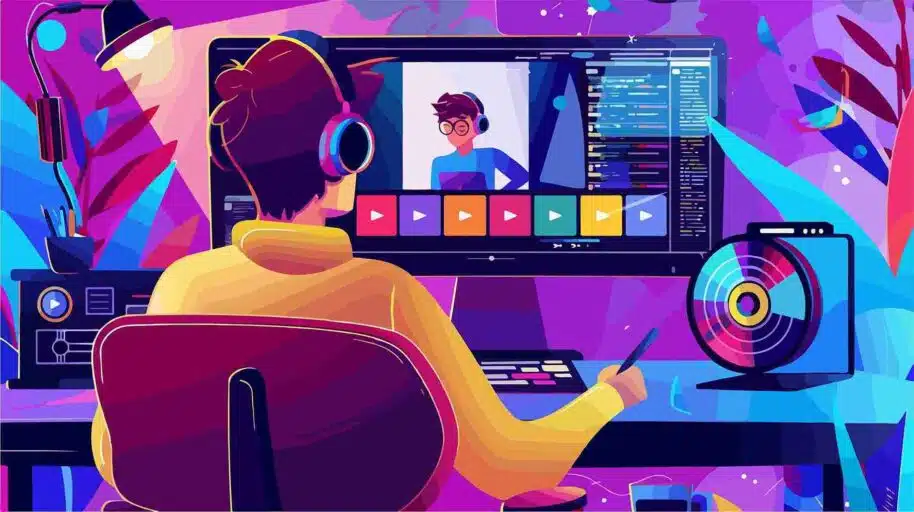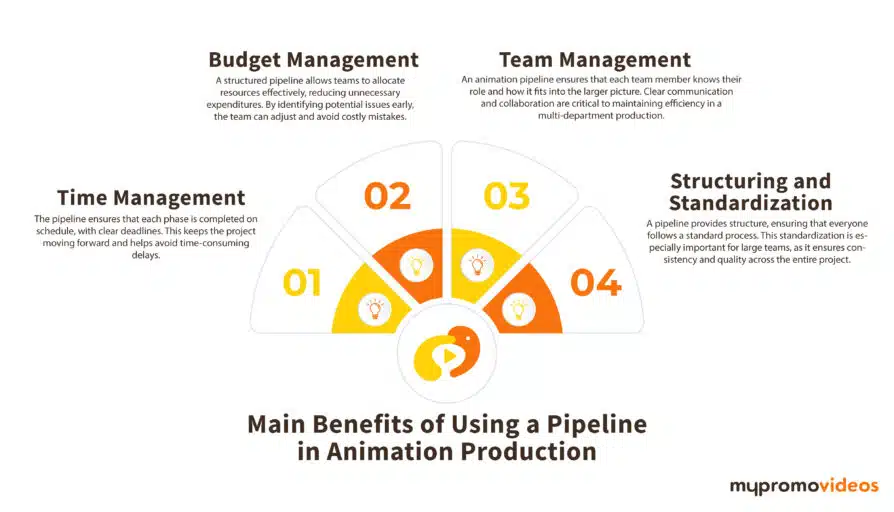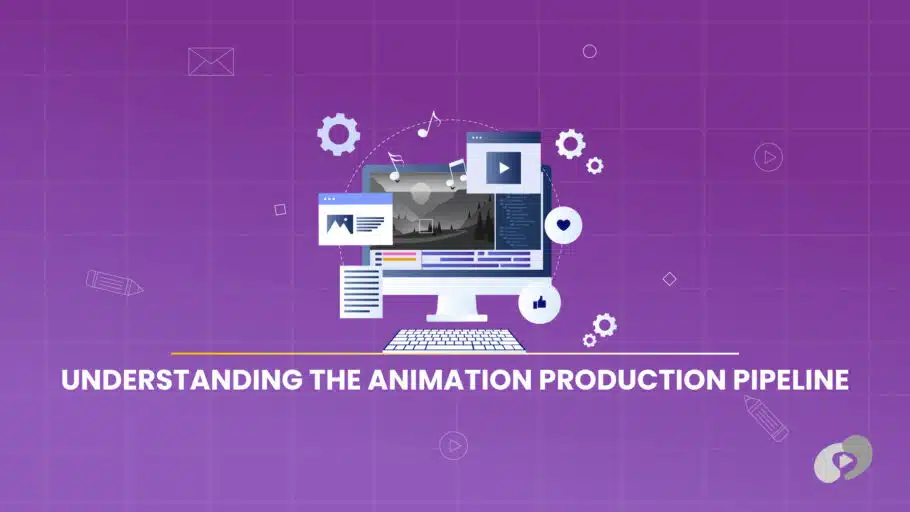Last Updated on February 6, 2025
Article Contents
Animation Production Pipeline: A Start-to-Finish Guide (2025 Update)
Animation is a complex and creative process that requires careful planning and coordination. A key part of ensuring successful animated content is the animation production pipeline. This pipeline is a step-by-step workflow that guides a project from the initial concept all the way to the final output, ensuring smooth transitions between stages and maintaining a clear structure. In this guide, we’ll dive deep into the animation production pipeline, focusing on its three main phases: pre-production, production, and post-production. By Understanding the Animation Production Pipeline, you can streamline your workflow and create high-quality animation with greater efficiency. Understanding the animation pipeline is crucial for creating high-quality animated content. For more insights, check out our list of the best animation websites.
What is an animation production pipeline?
An animation production pipeline is the structured series of processes that a production team follows to create an animated project, such as a film, commercial, or series. It involves breaking down the project into clear stages, where different teams handle specific tasks before passing their work to the next team in the pipeline. The goal of a pipeline is to ensure every stage of animation production runs smoothly, allowing teams to work efficiently without overlaps or delays.

Whether you’re working on 2D or 3D animation, the pipeline plays a crucial role in managing tasks, resources, and deadlines. For those focused on creating 3D animation, following a 3D animation pipeline ensures the complex layers of modeling, rigging, texturing, and lighting are handled methodically.
Key components of the animation production pipeline
An animation production pipeline is divided into three major stages: pre-production, production, and post-production. Each stage has specific steps and responsibilities, all aimed at bringing the animated project to life.
1. What is pre-production in the animation pipeline?
Pre-production is the foundation of any animation project. This phase involves planning and brainstorming, laying the groundwork for what the final product will look like. It’s all about refining the idea before any actual animation starts.
Idea Generation
The first step in pre-production is coming up with the initial concept for the project. This includes brainstorming ideas and developing a rough vision for the story or message that the animation will convey.
Story Creation
Once the idea is formed, it’s time to develop the story. This involves outlining the plot, identifying key characters, and determining the main events. In the case of a commercial, it could be outlining the core message the brand wants to communicate through the animation.
Script Writing
The script serves as the backbone of the entire animation. It outlines dialogue, action, and pacing. A well-constructed script ensures that the story is cohesive and engaging. It’s essential for keeping the animation team aligned with the narrative goals.
Storyboarding
Storyboarding is a visual breakdown of the script. It maps out every scene through sketches, helping the team visualize the flow of the animation. Developing strong storyboard ideas early in the animation pipeline ensures a clear vision and smooth production process. This stage also includes discussions on camera angles, character movement, and transitions. The storyboard is a crucial guide for the entire production pipeline.
Animatic
An animatic is a rough, animated version of the storyboard. It includes timing and pacing for each scene and often includes temporary audio tracks. The animatic helps the team assess how the animation will unfold and make adjustments before the full production begins.
Design
During the design phase, character designs, backgrounds, and other visual elements are created. This involves developing concept art that establishes the look and feel of the animation. For a 3D animation pipeline, this also includes designing models that will later be built and textured during the production phase.
2. What is the Animation Production Process?
The production phase is where the actual creation of animation happens. This is the heart of the 3D animation pipeline, where each frame and scene comes to life through modeling, rigging, texturing, and animation.
Layout
In the layout stage, the general positioning of characters and objects is blocked out, and camera movements are planned. This helps animators set up the basic framework of each scene, ensuring that everything is in the right place and flows well.
Modeling
Modeling involves creating 3D characters, props, and environments. In pipeline animation 3D, modelers build digital assets that can be manipulated and animated later. This stage focuses on building objects with the correct dimensions and proportions.
Texturing
Texturing is the process of applying surface details and colors to models. This step adds depth and realism by incorporating materials like skin, fabric, or metal to the models, making them look lifelike.
Rigging
Rigging involves creating the skeleton or structure that allows a 3D character or object to move. This phase is crucial for animators, as it gives them the ability to manipulate the models and create realistic motion.
Animation
The animation phase is where characters and objects are brought to life. Animators use keyframes to create movement, and software interpolates between those keyframes to generate smooth motion. This is the stage where the story starts to take shape through action.
VFX
Incorporating visual effects (VFX) adds an extra layer of realism or magic to the animation. Whether it’s explosions, smoke, water, or magic spells, the VFX team works to integrate these elements seamlessly into the scenes.
Lighting
Lighting enhances the mood and tone of the animation. Lighting artists decide how each scene is illuminated, creating shadows, highlights, and other effects that make the animation visually appealing.
Rendering
Rendering is the process of converting 3D models, textures, and animations into a final 2D image or video. This is one of the most time-consuming stages of the 3D animation pipeline, as it transforms raw data into the final polished frames.
3. What is the Post-Production Process in Animation?
Post-production is the final phase, where everything comes together to produce the final version of the animation. This includes editing, sound mixing, and adding any final touches.
Compositing
Compositing involves combining multiple elements, like different animation layers, background plates, and visual effects, into a single cohesive scene. This step ensures that all visual components blend together seamlessly.
VFX
In the post-production phase, additional VFX are added as needed. This can include touch-ups to previously added effects or integrating new ones that enhance the storytelling.
Color Correction
Color correction adjusts the colors in each scene to ensure visual consistency across the entire animation. It can also be used to set the mood of specific scenes, making colors brighter or darker depending on the tone.
Final Output
The final step in the animation production pipeline is outputting the completed animation. This involves creating the final video file, ensuring it’s in the correct format, and preparing it for distribution.
Why Use a Pipeline for Animation Production?

A production pipeline in animation ensures that every phase of production is organized and efficient. It minimizes the risk of bottlenecks, miscommunication, and errors, which can lead to costly delays. By following a structured pipeline, teams can collaborate more effectively, focusing on their specific roles while ensuring the animation moves through each stage smoothly.
Main Benefits of Using a Pipeline in Animation Production

Time Management
The pipeline ensures that each phase is completed on schedule, with clear deadlines. This keeps the project moving forward and helps avoid time-consuming delays.
Budget Management
A structured pipeline allows teams to allocate resources effectively, reducing unnecessary expenditures. By identifying potential issues early, the team can adjust and avoid costly mistakes.
Team Management
An animation pipeline ensures that each team member knows their role and how it fits into the larger picture. Clear communication and collaboration are critical to maintaining efficiency in a multi-department production.
Structuring and Standardization
A pipeline provides structure, ensuring that everyone follows a standard process. This standardization is especially important for large teams, as it ensures consistency and quality across the entire project.
Advancements in Animation Production Pipelines for 2024
As technology continues to evolve, the pipeline animation 3D process is becoming more streamlined. In 2024, new tools and AI-driven software are helping teams optimize workflows, improve render times, and enhance collaboration between departments. Cloud-based rendering, real-time feedback systems, and AI-enhanced animation tools are set to revolutionize how animators work.
How to Get Started in Animation Production
1. What Do I Need to Get Started in Animation Production?
To start in animation production, you’ll need basic tools such as animation software (like Blender or Maya), a strong understanding of the animation process, and a solid foundation in design, modeling, or rigging.
2. Do You Need to Know How to Draw to Be a Good Animator?
While drawing skills can be beneficial, especially in pre-production, they aren’t mandatory for a career in animation. Many 3D animators rely on modeling, rigging, and software tools to create animations without the need for traditional drawing skills.
3. How Is Animation a Career?
Animation is a rewarding career with opportunities across various industries, from entertainment to education and advertising. As demand for content grows, so do job opportunities for animators skilled in following the production pipeline.
4. How Do You Make a Great Animation Portfolio?
A strong portfolio should showcase your best work across different stages of the 3D animation pipeline. Include examples of modeling, texturing, and animation to highlight your versatility and understanding of the production process.
By understanding and utilizing the animation production pipeline, you can efficiently manage projects and produce high-quality animations from concept to completion. Whether you’re creating 2D or 3D animations, a well-organized pipeline will ensure the smooth execution of every step.

